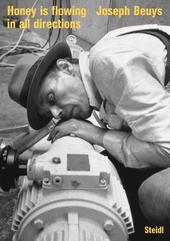
|
Joseph Beuys: Honey is flowing in all directions (2002)
Hardback
Main Details
| Title |
Joseph Beuys: Honey is flowing in all directions (2002)
|
| Authors and Contributors |
By (author) Gerhard Steidl
|
|
By (author) Klaus Staeck
|
| Physical Properties |
| Format:Hardback | | Pages:104 | | Dimensions(mm): Height 297,Width 210 |
|
| Category/Genre | Individual artists and art monographs |
|---|
| ISBN/Barcode |
9783958299153
|
| Classifications | Dewey:709.2 |
|---|
| Audience | |
|---|
| Illustrations |
86 Illustrations, unspecified
|
|
Publishing Details |
| Publisher |
Steidl Publishers
|
| Imprint |
Steidl Verlag
|
| Publication Date |
16 June 2022 |
| Publication Country |
Germany
|
Description
Kassel, documenta 1977. A pump driven by two strong motors forces two tons of honey over a 17-meter-high pipe into a network of tubes that traverses the rooms of the Fridericianum Museum. This was the core of Joseph Beuys' Free International University for Creativity and Interdisciplinary Research which he brought to life at documenta 6. Around his Honeypump in the Workplace Beuys created events that expanded his notion of art and starkly differentiated it from tradition. For Beuys, "workplace" meant talks, speeches, workgroup discussions and citizens' action committees. For 100 days he tirelessly expressed his ideas on how art and society must necessarily change, filling numerous blackboards with texts, diagrams and musical scores. On 28 June 1977 Beuys invited Klaus Staeck and Gerhard Steidl to join him in servicing and maintaining his honeypump, which was carefully documented in the photographs of this book, first published in 1997 and now re-conceived by Staeck and Steidl. Truth must be found in reality, not systems. - Joseph Beuys
Author Biography
Widely regarded as one of the most influential artists of the twentieth century, Joseph Beuys (1921-86) was a sculptor, draughtsman, action and installation artist, as well as a teacher, politician and activist. After serving as a soldier in World War II, experiences that would strongly shape his practice, he studied sculpture at the Kunstakademie Dusseldorf, where he was made professor in 1961. From the early 1960s Beuys dissolved the difference between his biography and art, and increasingly employed his persona and charisma in what he deemed art's ultimate purpose: to radically democratize society. He called for the adoption of his universalist conception of art as a creative, transformative force within politics, science, philosophy and economics. Now as then, Beuys exerts a palpable influence upon artistic and political discourse.
|